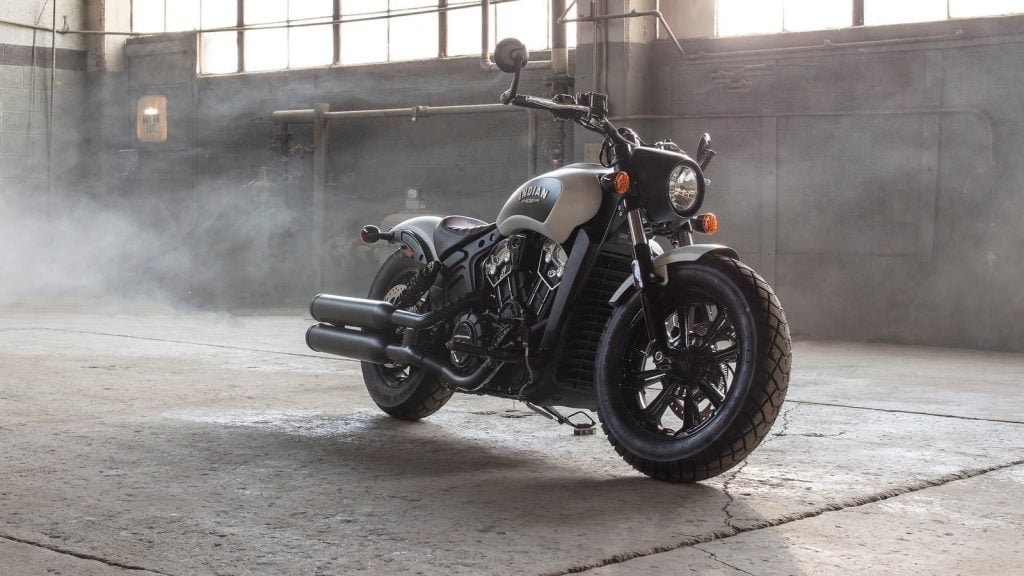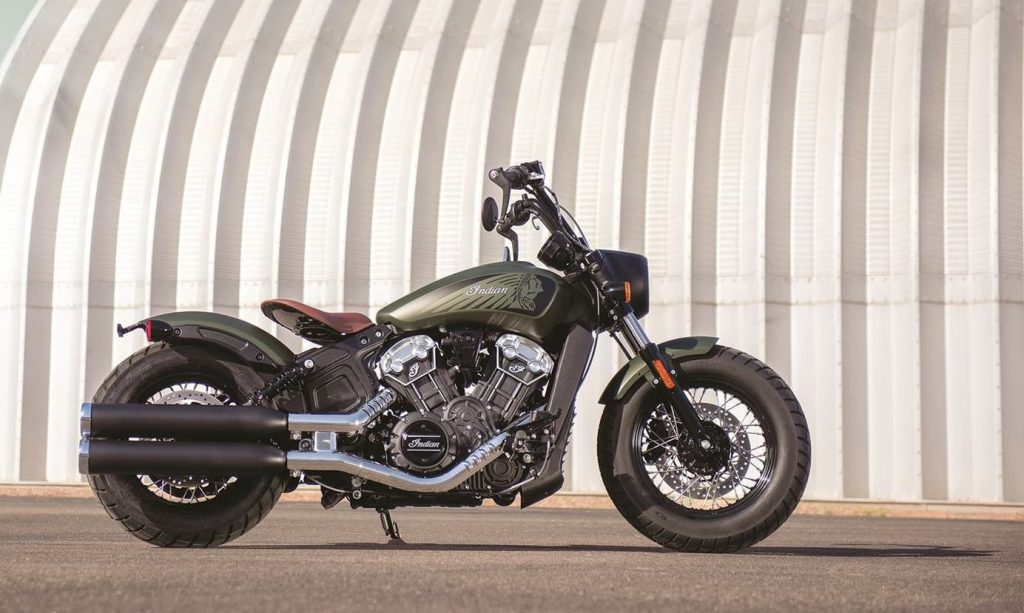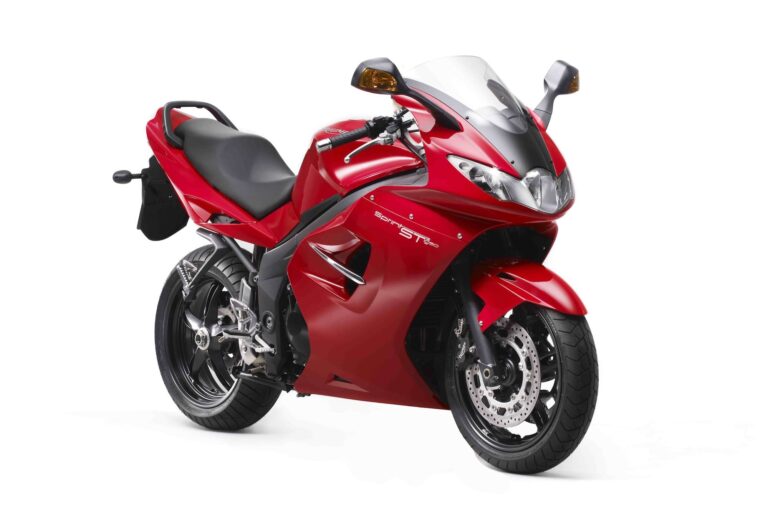Indian Scout Bobber (2018+, including Twenty and Sixty) Maintenance Schedule
This is the maintenance schedule and service intervals for the Indian Scout Bobber, one of the most popular motorcycles out of the revitalised Indian brand in recent years.
The Indian Scout Bobber uses the same basic platform as the Indian Scout, but is lower, sleeker, and somehow just a lot cooler. The Scout Bobber has a 1133cc water-cooled V-twin that produces around 100hp, revving quite high for a cruiser.
Unlike the Scout, the Scout Bobber has handlebars that are a bit lower and closer, mid controls (still quite far forward compared to e.g. a Bonneville), lower rear suspension (two inches of travel rather than three), and of course, a single seat with no rear seat, much less a rear rest.
The Scout Bobber also comes in two other configurations:
- Scout Bobber Twenty: basically the same bike but with taller handlebars so you’re not quite so folded over
- Scout Bobber Sixty: smaller motor (and slightly less power), and some downgraded components
Maintenance for the Indian Scout Bobber has a lot in common with the Indian Scout, though the latter has some different components.
Indian upgraded the Scout to a 1250cc motor from model ear 2025. Find the maintenance schedule for the 2025+ model here.
This site has links for things like oil and spark plugs from which we earn a commission (which unfortunately nobody can save, not even us). If you appreciate this work, then please use those links. Thanks!
Indian Scout Bobber Service Intervals
The easiest way to think of the service intervals for the Indian Scout Bobber is the oil change interval, which is every 10000 miles or 16000 km. But Indian recommends you do a full inspection twice as often, every 5000 miles or 8000 km. At every service, Indian has a full checklist of items to go over.
Unlike other big cruisers, the Indian Scout Bobber does not have self-adjusting hydraulic valve lifters. So you do have to inspect the valve clearances periodically. The recommended valve service schedule is every 20000 miles or 32000 km — every two oil changes.
Indian recommends you change the spark plugs in the Bobber only at 30000 miles / 48000 km.
There are other items with odd maintenance intervals, like the fuel filter or drive belt — see the maintenance table below for more details.
What you need to service your Indian Scout Bobber
Servicing your Indian Scout Bobber may seem intimidating if it’s your first bike (not an uncommon occurrence!) but it’s not hard. You should regularly change the oil and filter, and check and adjust the belt tension at a minimum.
| Part | Indian Scout Bobber spec |
|---|---|
| Engine Oil | Indian recommends “Indian motorcycles Synthetic Blend 15W-60 Engine Oil for your motorcycle”. This is an oil that meets API SM and ILSAC GF-4, and JASO MA specifications and that’s 15W-60 in weight. Your best bet is an Indian Scout Oil Change Kit, which includes an oil filter. |
| Oil filter | Change the oil filter every time you change the oil. An oil filter is included with the oil change kit, or you can separately get a Hiflofiltro part number HF199. |
| Belt tension | Check the belt tension regularly with a belt tension tool and adjust if necessary. |
| Air filter | You need to change the air filter every 10,000 miles (16,000 km). The part number is PL-1115. |
| Spark plugs | Change spark plugs periodically with an NGK MR7F with an 0.030 inch (0.80 mm) gap (you might need a spark plug gapping tool) |
| Battery | Dead battery? Replace it with a 12 volt, 13 amp-hour, 245+ CCA maintenance-free AGM, e.g. Yuasa YTX14AH-BS, used in many high-end motorcycles. |
| Light bulb | Standard headlight bulb size HB2 60/55W 12V LL. |
Maintenance Schedule for the Indian Scout Bobber
This is the maintenance schedule for the Indian Scout Bobber, just reformatted to make it easier to read.
Generally, inspect, clean, lubricate, adjust and replace parts as necessary. When inspection reveals the need for replacement parts or components, Indian recommends you use genuine Indian Motorcycle parts.
Record service and maintenance information in the “Maintenance Log” in your manual.
Notes:
- The maintenance schedule goes until 50K miles (80K km) as some items only need very infrequent service
- If you subject your motorcycle to “extreme use”, inspect and service it more frequently. “Severe use” includes: 1. high-speed operation for extended periods, 2. low-speed operation for extended periods, 3. operation in dusty or otherwise adverse conditions, and 4. operation in cold weather (temperatures below freezing).
Indian Scout Bobber — Standard Service
Below is the standard inspection checklist for the Indian Scout Bobber. Do this according to the maintenance schedule below.
| Indian Scout Bobber – inspection checklist |
|---|
| Drive belt condition and tension – inspect, adjust tension as necessary See below for inspection / adjustment guidelines |
| Cooling system / Radiator – inspect for leaks, chafing |
| Fuel system – inspect for leaks, chafing |
| Oil lines / Oil system – inspect for leaks, hose condition |
| Engine coolant – check level |
| Brake Pads – inspect wear condition, replace as necessary |
| Front brake lever – inspect, lubricate |
| Front forks and axle – inspect for leaks, smooth operation, no free play |
| Gear shift pedal – inspect |
| Rear brake pedal – inspect |
| Rear shock absorber – inspect for no leaks, smooth operation |
| Rear wheel alignment – inspect, adjust as necessary |
| Side stand – inspect, lubricate as necessary |
| Side stand safety switch – inspect |
| Feeler pegs – inspect, replace as necessary |
| Steering Bearings – inspect for smooth operation, no notchiness |
| Shock Bushings and Fasteners – inspect |
| Swing Arm, Rear Axle, Swing Arm Pivot, and Pivot Bearings – inspect for tightness / lack of play |
| Tires / Wheels – inspect for condition, tread |
| Fasteners – tighten as necessary |
| Headlight – inspect for function, correct aim |
| Crankcase ventilation system – inspect |
| Evaporative emission control system (if fitted) – inspect |
| Battery – check tightness, replace battery as necessary |
| Road test – perform |
Indian Scout Bobber — Scheduled Service
This is the maintenance schedule for the Indian Scout Bobber.
If there’s a time-based and distance-based item, follow the earlier of the two intervals. E.g. replace brake fluid every 10000 miles or 2 years, whichever comes first.
| ‘000 Miles | 2.5 | 5 | 10 | 15 | 20 | 25 | 30 | |
|---|---|---|---|---|---|---|---|---|
| ‘000 km | 4 | 8 | 16 | 24 | 32 | 40 | 48 | Every |
| Perform full scheduled service (see above) | ✓ | ✓ | ✓ | ✓ | ✓ | ✓ | ✓ | |
| Engine oil – replace | ✓ | ✓ | ✓ | Year (if driven in extreme conditions) | ||||
| Engine oil filter – replace | ✓ | ✓ | ✓ | Year (if driven in extreme conditions) | ||||
| Air filter – inspect | ✓ | ✓ | ✓ | ✓ | ||||
| Air filter – replace | ✓ | ✓ | ✓ | |||||
| Spark plugs – check | ✓ | ✓ | ||||||
| Spark plugs – replace | ✓ | |||||||
| Engine compression – check | ✓ | ✓ | ✓ | |||||
| Exhaust joints – Check and re-torque | ✓ | ✓ | ✓ | |||||
| Valve lash clearance – check / adjust | ✓ | |||||||
| Brake fluid level – inspect | ✓ | ✓ | ✓ | ✓ | ||||
| Brake fluid – replace | ✓ | ✓ | ✓ | 2 years | ||||
| Lubricate clutch lever | ✓ | ✓ | ✓ | |||||
| Lubricate control cable ends | ✓ | ✓ | ✓ | |||||
| Front fork oil – replace | ✓ | ✓ | 2 years | |||||
| Fuel filter – replace | ✓ | |||||||
| Drive belt – replace | ✓ |
Long-term service for the Indian Scout Bobber
The below items only need service very infrequently — they’re not part of of the regular maintenance schedule. Many owners may never come across them.
Where there’s a distance and time interval, follow the earlier of the two
| Service Item | Distance interval | Time interval |
|---|---|---|
| Engine coolant — replace | 50000 miles / 80000 km | 5 years |
| Rear shock absorber – replace | 50000 miles / 80000 km | – |
Drive belt maintenance
At every service interval, check the Scout Bobber’s belt condition. You want to make sure it has no cracked or broken teeth.
See the below examples from the Indian manual (showing only the situations where you should replace the belt).

You also need to check the deflection level of the drive belt.
The belt on the Indian Scout Bobber, with 10 lb of force, should deflect to 12 mm (15/32 in).
If the belt is too loose, adjust the belt tension by loosening the axle nut, turning the left side adjuster nut to get the correct tension. Make sure the belt is aligned using the right side adjuster nut.
Once you’ve set the belt tension and ensured that the belt alignment is correct, tighten the axle nut again (torque spec 65 ft-lb / 88 Nm).
Tire sizes and pressures
The Indian Scout Bobber ships with the following tyre sizes and recommended pressures. The standard tire is a Pirelli MT60RS.
| Wheel | Tire size | Tire pressure (cold) |
|---|---|---|
| Front | 130/90B16 67H | 36 psi (248 kPa) |
| Rear | 150/80B16 77H | 40 psi (276 kPa) |
The recommended tire pressures are the same for the standard Scout Bobber, Twenty, and Sixty, and are the same recommended pressures with any load, with or without a passenger. (J/k it’s a bobber, you’re not taking a passenger…)
Of course, recommended tire pressures are often to minimise tyre wear and associated expense, so find the ideal pressure for your weight and ride style.
About the Indian Scout Bobber
The Indian Scout had already been successful for a few years before Indian Motorcycles decided to release the Indian Scout Bobber for the 2018 model year.
The basic platform for the Indian Scout is unchanged. It’s still powered by a 1133cc liquid-cooled eight-valve 60-degree V-twin that makes a claimed 94 hp (70kW) at the crank, and 97 Nm (130 ft-lb) at 5,600 rpm. There’s a six-speed transmission and a belt drive.
All that is for a motorcycle that weighs a pretty heavy (but also pretty reasonable for a cruiser) 255kg wet — I think of this as “quite a lot more than a similarly-powered Triumph Bonneville Bobber, but not as much as a much slower Harley-Davidson Iron 883″.
The Scout’s engine is quite fun to use, making this a good transition bike for sportbike riders who want to try a cruiser. Normally, if you’re used to sportbikes, you might be frustrated with bigger cruisers’ inability to rev. The Scout Bobber’s engine does rev nicely to 7000 rpm, so while you’re not going to the moon, you won’t feel like it’s “choking” as you might feel on other bikes.
Differences for the Indian Scout Bobber vs the original are
- Mid-control foot-begs (38mm closer)
- Flatter handlebar
- Solo seat, no rear seat/grab rail
- Shorter 50mm/2 inches rear suspension (vs 75/3 inches)
The riding position of the Scout Bobber is aesthetically cool-looking, but a little difficult for distance. There’s no escaping the fact that with the low handlebars and mid controls you’re quite folded over.
Still, people really enjoy the Scout Bobber for medium distances, and you can even get saddlebags for it… though they look more at home on the original Indian Scout.
Suspension on the Indian Scout Bobber is quite minimal. The standard (right-side-up) cartridge forks are non-adjustable, and the rear twin shocks are preload-adjustable with just 50mm (2 inches) of travel. So don’t go planning on doing any jumps with it.
The low suspension also means it’s quite easy to scrape the Indian Scout Bobber. Going around a freeway on-ramp somewhat aggressively or doing a quick left-hand turn at an intersection will result in you making contact. Because the motorcycle is low, you have to lean it more to turn it… so it’s a catch-22 in that regard.
Maintaining the Indian Scout Bobber is quite easy. There’s a belt drive, so you have to check the tension and make adjustments periodically. Valve service intervals are quite wide — every 20,000 miles or 30,000 km, which is in the same territory as other modern Japanese and European water-cooled motorcycles.
Variants of the Indian Scout Bobber are
- Scout Bobber Twenty: Named for the first Indian Scout in 1920 (and this one, released in 2020). Has 10-inch “ape-hanger” bars. This transforms the riding position into kind of like a standard (like a Bonneville with your feet slightly forward), and standard low-slung rear-view mirrors (which are actually unusable in practise… your fore-arms are always in the way)
- Scout Bobber Sixty: Named for the 60-cubic inch engine that’s slightly lower-power. Has a five-speed transmission and a lower price. Has otherwise the same chassis and ergonomics as the Scout Bobber, and pretty much the same weight.
The Indian Scout Bobber is quite unique in that it has a liquid-cooled engine. But the 2020+ Indian Challenger, with its liquid-cooled PowerPlus engine, became the second Indian cruiser with liquid cooling.
Manual for the Indian Scout Bobber
The above maintenance schedule was transcribed from the manual for the Indian Scout Bobber, which it shares with the Scout Bobber Twenty and Scout Bobber Sixty.
However the format in the manual makes it harder to follow, as it’s in a semi-arbitrary order and a huge table.

You can get the original manual from Indian’s website, here.















